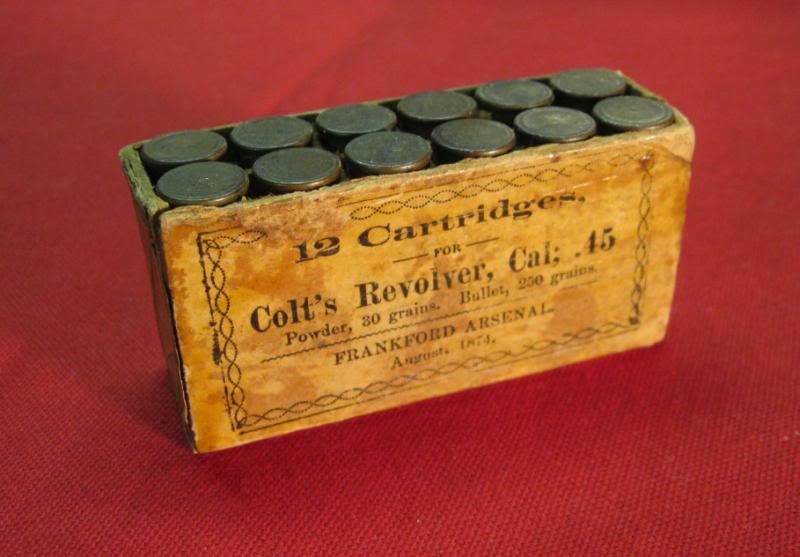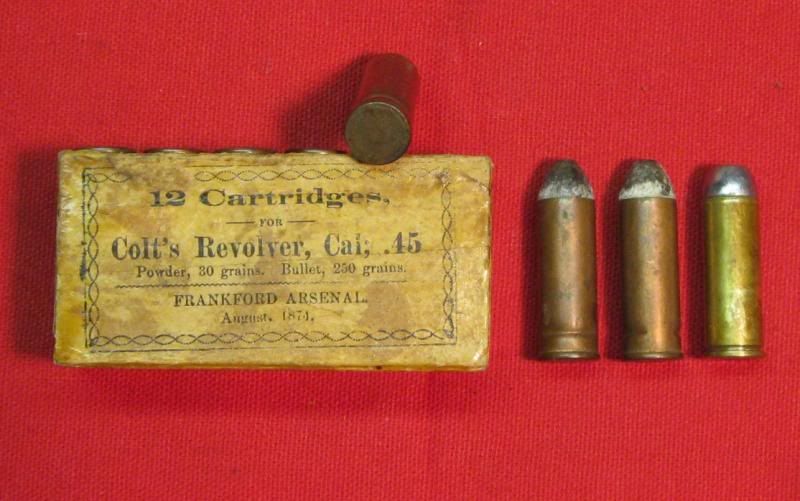Howdy Again
Although we read all the time about 45 Colt containing 40 grains of Black Powder, just about the only version that was actually able to contain 40 grains were the original Benet primed, folded rim rounds. The balloon head rounds that came along slightly later had less interior case capacity and 38 grains was more the norm for them.
Here is a photo of a box of antique 45s I purchased recently. Notice they only contain 30 grains of powder. As the box says, these were made at Frankford Arsenal for the Army in 1874. I am not going to take one of these apart, but I suspect there is cardboard wadding inside to take up the extra volume, as there was with the Army's 45-70 carbine loads. Yes, some of the very early Colts did blow up with 40 grains, partially because Colt was still using malleable iron, not steel for the very early frames and cylinders.

This photo shows a few of the antique Benet primed rounds alongside a modern round. Notice they are copper cased, not brass. Notice also they appear to be rimfire as there is no visible exterior primer. Benet priming was an early form of centerfire priming developed for the Army. Priming compound was sprayed onto the flat, inside face of the case head. An Anvil Plate was then pressed against the priming compound and secured in place with two crimps near the base. That is what the crimps are on these rounds. When the firing pin struck the rear of the case, the priming compound was compressed between the soft copper case and the interior anvil plate. The flame from the ignited priming compound passed through two holes in the anvil plate to ignite the powder charge. Early 45-70 rounds were constructed the same way. Because there was no separate primer, Benet primed rounds were not reloadable.

The 40 grain 45 Colt loads would have looked exactly like this. Inside would be 40 grains of powder and no wadding.
Regarding 44-40: I have loaded it for many years with Black Powder. I have no revolvers chambered for 44-40 but I have five rifles chambered for the cartridge. Some are antiques, some are of modern manufacture. I have slugged them all. An Uberti replica of the Winchester Model 1873, an antique Winchester Model 1892, and an antique Marlin Model 1894 all have .427 diameter rifling grooves. A Winchester Model 1892 Saddle Ring Carbine made in 1916 has .429 rifling, as does a recently made Uberti replica of the 1860 Henry.
I used to use .427 bullets in all my 44-40 loads. I found that the Uberti 1873 with its .427 rifling shot well with .427, .428, and .429 bullets. However the .429 bullets caused the case mouth to swell just enough that the rounds were a little bit stubborn to chamber. That is the other point about 44-40. Sometimes with a modern .429 barrel, .429 or .430 bullets may cause the case mouths to swell just enough that chambering can be a bit stubborn. This was a particular problem with the 44 Special/44-40 convertible Ruger Vaqueros that were made a number of years ago. The fact that the chamber throats were undersized, around .425, did not help matters. Shooters reported that after opening up their chamber throats a few thousandths, accuracy problems went away. Good advice to shooters with .429 rifling is to use the thinnest brass available. I have had good results with both Winchester and Starline 44-40 brass, they seem to have the thinnest necks, only about .007 thick at the case mouth. Some brands may have thicker brass at the case mouth which may cause the case mouths to swell a bit more with 'large diameter' bullets like .429 or .430.
Today I am sizing my 44-40 bullets to .428, as a compromise between the .427 and .429 rifling in my different rifles. It seems to work fine. I cast my bullets from dead soft, pure lead, so they may be bumping up in diameter in the rifling.
Or maybe not. In any case accuracy is fine with my .428 bullets and .427 and .429 rifles.


